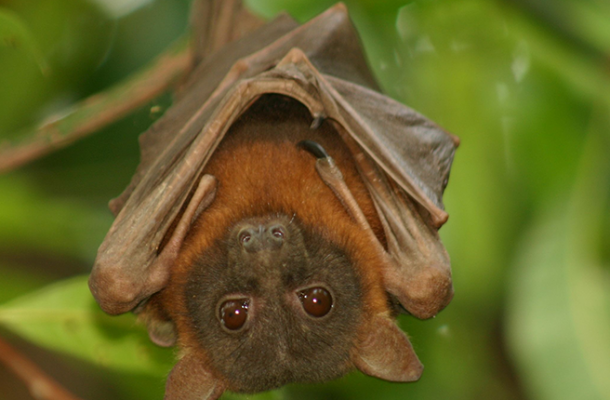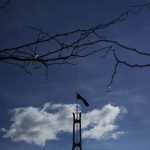Who gives a flying fox?

Canoeing on the lower reaches of Melbourne’s Yarra River is a rewarding way to spend a fine December afternoon. It wasn’t the first time I had been on the river but 50 years before I hadn’t seen it in quite the same way. But times have changed and so has the way things are done, or seen to be done, outcomes notwithstanding.
It’s refreshing and pleasantly surprising to see Kingfishers, Darters, Night Herons, Cormorants and Ducks in what appearances might suggest is a ‘wild’ setting. Magnificent River Red Gum trees line the banks and other remnant native vegetation completes the idyllic scene. My canoeing companion remarked that it reminded him of the ‘mighty Murray’.
A little way upstream from Studley Park boathouse, there are signs asking visitors to “pass quietly” through a fruit bat (Flying Fox) colony’s roosting area which extends for almost a kilometre along both banks of the river. The din created by these creatures makes you wonder how much noise it would take to disturb them.
All sorts of methods to move them on have been tried elsewhere, usually without success, where the bats have caused nuisance, economic loss and risks to human health. Perhaps the signs were intended to be read by the Fruit Bats.
As John Passmore observed in “The Limits of Government”, to be seen to be doing something is the primary concern of governments, especially when they have no idea what to do. To placate the demands of perceived public opinion requires imagination. Far better to relocate the problem than to concede that we have released ecological forces here, as elsewhere, that we cannot control.
The ‘out of sight, out of mind’ approach worked so well for liquid and solid wastes, why not stay with it by creating a kind of isolated ‘ghetto’ to be occupied by inconvenient ‘ecological refugees’ like Fruit Bats. Isolating these animals is like relocating humans and pretending that will eliminate poverty.
A kind of unresolved duality exists here between protection and exclusion, even persecution, of native animals which is usually reserved for introduced pests such as rabbits and foxes. Could it be that our need to keep up environmental appearances is greater than our concern for the Fruit Bats?
Could the damage inflicted on the riparian vegetation by such a concentration of Fruit Bats be a result of human interference in the riparian ecosystem?
It is generally accepted that Fruit Bats are essential to the maintenance of healthy forest ecosystems. But it does seem ironic that the riparian vegetation is obviously being degraded by more Fruit Bats than the riparian ecosystem seems able to support.
However, the stability of river banks largely depends on vegetation. The forest ecology rationale for management of the Fruit Bats does seem weak in view of the evidence.
It appears that the already modified ecosystem is under severe pressure. So it is hard to see how allowing the Fruit Bat colony to grow and concentrate to the detriment of its habitat is consistent with ecosystem protection or maintaining biodiversity.
That evening as I watched the squadrons of Fruit Bats heading off to feed, I wondered what our response would be if the river changed its course, perhaps threatening a golf course or expensive real estate. That would indeed test the environmental resolve of both government and the community.
It’s a very rough estimate, but there must have been something like 10,000 Fruit Bats roosting in more than 100 trees that appeared to be severely stressed. Many of the trees would be at least 100 years old, some probably much older. What does that suggest about the behaviour of the bats and the effect of human interference?
Another interesting aspect on this part of the river is that it was once frequented by one of Australia’s greatest scientists. It is nice to think of the young Frank Macfarlane Burnet wandering and wondering in the beginning of his great career in medical science, immunology.
But returning to the Fruit Bats, Australian bat lyssavirus (ABLV) is a virus that can be transmitted from bats to humans, causing serious illness. It is likely that any bat in Australia could carry the virus. Assuming 10,000 were roosting in the trees along that stretch of the Yarra, 1% or around 100 of them of them may have been potential carriers of the virus. Although the risk of contact with humans could easily be exaggerated, it was enough for us to steer clear in midstream away from overhanging branches.
In a handful of decades we have seen a shift from externalising the true costs of our extravagance onto the environment, to an ideologically-driven quasi-religious, misanthropic environmentalism that fails to recognise the nexus between health and the environment.
It would be presumptuous in the extreme to put words in the mouth of Sir Frank Macfarlane Burnet, OM, AK, KBE, FRS, FAA, FRSNZ but it seems reasonable to wonder what he would have made of concentrating highly mobile disease vectors in the middle of the city with unrestricted access from nearby public recreation areas. Just asking!

Max Thomas, Dip. Agric. (retired) worked in the public sector and in private consulting on a range of land, water and waste management projects. He prepared guidelines for irrigation with recycled water for EPA Victoria and developed a number of Environmental Management Systems in the water industry.













